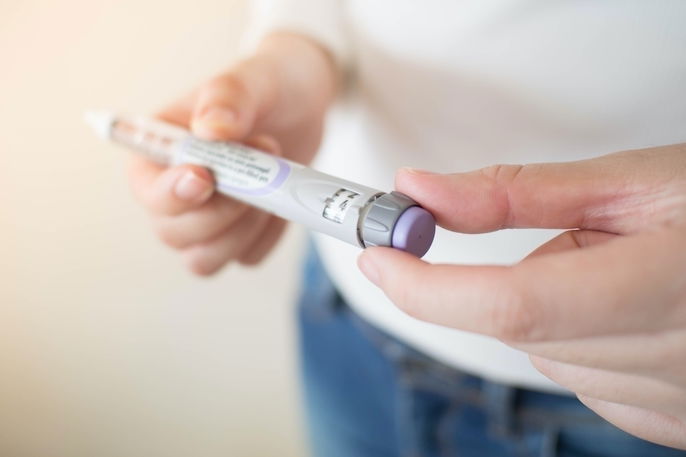Saxenda is an injectable medication used for weight loss for patients who are obese or overweight. It helps to reduce appetite and manage body weight, and can lead to a reduction of up to 10% of total body weight when combined with a healthy diet and active lifestyle.
This medication contains contains liraglutide in its composition, which acts on the areas of the brain that regulate appetite. This can help you feel less hungry, helping to reduce the total number of calories consumed in a day.
Saxenda is available for purchase at pharmacies with a prescription in the form of a pen for injection into subcutaneous tissue. It contains 3 mL of liraglutide injectable solution, with dosing guided by your doctor according to your treatment plan.

What it's for
Saxenda is indicated for the treatment of:
- Obesity with a BMI greater than 30 kg/m2;
- Overweight with a BMI greater than 27 kg/m2, associated with diseases such as high blood pressure, diabetes mellitus, dyslipidemia or high cholesterol.
The body mass index (BMI) is used to help calculate the ideal weight for a patient, and can help to guide diet and weight loss planning. Find out your BMI using our online BMI calculator to determine whether you are a candidate for this medication.
How to take and doses
Saxenda should be used as prescribed by your doctor. The recommended dose is 1 subcutaneous injection per day subcutaneously, meaning that it is applied under the skin of the abdomen, thigh or arm. It can be injected at any time of the day, regardless of meal times.
Saxenda doses depend on the week of treatment and include:
The maximum dose is 3 mg per day and should not be exceeded. It is important to follow the treatment plan as outlined by your doctor, with the doses and duration maintained as prescribed.
If you forget to inject a dose at the correct time, you should apply it as soon as you remember. However, if more than 12 hours have passed, you should skip the missed dose and apply the next dose at the normal time. Do not take a double dose to make up for a forgotten dose.
When taking Saxenda, you should maintain a balanced diet and exercise regularly, as recommended by your doctor.
How to inject
See the steps below to learn how Saxenda is injected:
- Remove the pen cap
- Place a new needle on the tip of the pen, screwing it on until tight
- Remove the external and internal protection from the needle, throwing away the internal protection
- Rotate the top of the pen to select the dose indicated by the doctor-
- Insert the needle into the skin, ensuring the pen is perpendicular, at a 90º angle to the skin
- Press the pen button until the dose marker shows the number 0
- Count slowly to 6, continuing to press the button and then remove the needle from the skin
- Place the outer needle cap and remove the needle, throwing it in a safe sharps basket;
- Attach the pen cap.
If you have any questions about how to use the pen and inject Saxenda, seek further guidance from your doctor or pharmacist.
How long does one Saxenda pen last?
The duration of the Saxenda pen depends on the week of treatment being carried out. The pen has a scale that display how many milligrams remain to be applied.
In general, each box of Saxenda contains 3 pens. This is typically sufficient for 3 months of treatment when using the minimum recommended dose and when stored correctly.
Saxenda should be stored in the refrigerator, at temperatures between 2º and 8ºC. You should avoid storing this medication on the refrigerator door to avoid temperature variations. Furthermore, an open Saxenda pen is good for use for 1 month.when stored in a refrigerator or at room temperature, below 30ºC. After this period, any unused quantity should be discarded.
Possible side effects
The most common side effects that may occur during treatment with Saxenda include nausea, vomiting, diarrhea, constipation, headache, dizziness, tiredness, or loss of appetite.
Although it is rare, some patients may report indigestion, gastritis, gastric discomfort, upper stomach pain, heartburn, gastroparesis, feeling of fullness, increased belching, intestinal gas, dry mouth, weakness or fatigue, changes in taste, gallstones, or reactions at the injection site reactions.
Furthermore, Saxenda can cause hypoglycemia, which is a sudden decrease in blood glucose levels. This conditions presents with symptoms such as increased hunger, excessive sweat production, irritability, dizziness, racing heart, feelings of anxiety or tremors. It is important to inform your doctor of any symptoms you may be experiencing.
Saxenda can also cause serious allergic reactions that require immediate medical attention. You should stop treatment and seek immediate medical attention if you experience symptoms such as difficulty breathing, difficulty swallowing, heart palpitations, dizziness, a feeling of a closed throat, severe itching or swelling in the mouth, tongue or face
Saxenda can also cause a rebound effect and lead to increased weight gain, especially after stopping treatment without guidance and ongoing monitoring from an endocrinologist.
Contraindications for use
Saxenda should not be used by children and adolescents under the age of 18, nor by pregnant or breastfeeding women, or by people who are allergic to liraglutide or any of the components present in this medication.
Furthermore, Saxenda should not be used by anyone with who have or have had a thyroid tumor, nor by anyone who uses other GLP-1 receptor agonist medications.






























